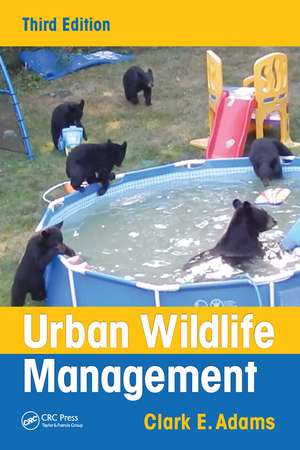Urban Wildlife Management
Autor Clark E. Adamsen Limba Engleză Paperback – 30 iun 2021
Urban development is one of the leading worldwide threats to conserving biodiversity. In the near future, wildlife management in urban landscapes will be a prominent issue for wildlife professionals. This new edition of Urban Wildlife Management continues the work of its predecessors by providing a comprehensive examination of the issues that increase the need for urban wildlife management, exploring the changing dynamics of the field while giving historical perspectives and looking at current trends and future directions.
The book examines a range of topics on human interactions with wildlife in urbanized environments. It focuses not only on ecological matters but also on political, economic, and societal issues that must be addressed for successful management planning. This edition features an entirely new section on urban wildlife species, including chapters on urban communities, herpetofauna, birds, ungulates, mammals, carnivores, and feral and introduced species.
The third edition features
- Five new chapters
- 12 updated chapters
- Four new case studies
- Seven new appendices and species profiles
- 90 new figures
- A comprehensive analysis of terrestrial vertebrate locations by state and urban observations
Each chapter opens with a set of key concepts which are then examined in the following discussions. Suggested learning experiences to enhance knowledge conclude each chapter. The species profiles cover not only data about the animal concerned but also detail significant current management issues related to the species.
An updated and expanded teaching tool, Urban Wildlife Management, Third Edition identifies the challenges and opportunities facing wildlife in urban communities as well as factors that promote or threaten their presence. It gives both students and professionals a solid grounding in the required fundamental ecological principles for understanding the effects of human-made environments on wildlife.
Preț: 465.29 lei
Nou
Puncte Express: 698
Preț estimativ în valută:
89.03€ • 92.96$ • 73.69£
89.03€ • 92.96$ • 73.69£
Carte tipărită la comandă
Livrare economică 04-18 aprilie
Preluare comenzi: 021 569.72.76
Specificații
ISBN-13: 9781032097961
ISBN-10: 1032097965
Pagini: 618
Ilustrații: 214 Illustrations, color
Dimensiuni: 178 x 254 x 32 mm
Greutate: 1.14 kg
Ediția:Nouă
Editura: CRC Press
Colecția CRC Press
ISBN-10: 1032097965
Pagini: 618
Ilustrații: 214 Illustrations, color
Dimensiuni: 178 x 254 x 32 mm
Greutate: 1.14 kg
Ediția:Nouă
Editura: CRC Press
Colecția CRC Press
Cuprins
Introduction: A New Wildlife Management Paradigm. HUMAN–WILDLIFE INTERFACE. Wildlife Management: Past and Present. Principal Components of Urban Wildlife Management. URBAN ECOSYSTEMS. Ecological Principles in an Urban Context. Urban Soils. Urban Aquatic Systems. Population Dynamics. URBAN HABITATS AND HAZARDS. Urban Green Spaces. Urban Gray Spaces. URBAN WILDLIFE SPECIES. Urban Herpetofauna (Amphibians and Reptiles). Urban Birds. Urban Mammals. Urban Threatened, Endangered, and Extirpated Species. Urban Introduced and Invasive Species. Resident Canada Geese and Urban White-Tailed Deer. URBAN SOCIOPOLITICAL LANDSCAPE. Human Dimensions of Urban Wildlife Management. Legal Aspects of Urban Wildlife Management. Zoonoses and Management Considerations. Appendix: Lists of Terrestrial Amphibians, Reptiles, Birds, and Mammals by State Those Observed in Urbanized Communities in the United States.
Notă biografică
Clark E. Adams is an emeritus professor in the Department of Wildlife and Fisheries Sciences (WFSC) at Texas A&M University in College Station. He earned his PhD in zoology from the University of Nebraska–Lincoln and completed a 51-year teaching and research career on August 31, 2015. He chaired the Conservation Education Committee for The Wildlife Society (TWS), edited the newsletter for the Human Dimensions of Wildlife Study Group, was a member of the Urban Wildlife Management Working Group, and has chaired many committees for the Texas Chapter of TWS. He is a former president of the Texas Chapter of TWS and as well as the Southwest Section of TWS. Since 1981, he and his students have conducted and published many national, regional, and statewide studies on the public’s activities, attitudes, expectations, and knowledge concerning wildlife. He developed the degree option in urban wildlife and fisheries management for the WFSC and developed and taught the senior-level urban wildlife management course. He received the 2015 Outstanding Achievement in Urban Wildlife Conservation award from the TWS Urban Wildlife Working Group. He is also the coauthor of Texas Rattlesnake Roundups.
Recenzii
As urban areas expand into surrounding natural habitat, there are inevitably more interactions between humans and wildlife. In this third edition, Adams (emer., wildlife and fisheries sciences, Texas A&M Univ., College Station) updates a work that filled a void no comprehensive treatment of the subject had previously existed. Significant enhancements to previous editions (CH, Oct'06, 44-0909) include five new chapters, four case studies, seven appendixes/species profiles, and 90 figures. Additional research and data mining contribute a significant amount of new information to this edition. New chapters highlight special management considerations for various types of urban vertebrates. A short profile of an urban species follows each chapter. Though examples and case studies are heavily focused on the United States, the general principles can apply to urban wildlife in any area of the world. Designed to serve as a textbook, this volume synthesizes current information and is the standard text on this subject. It can also serve as a general resource for those interested in this topic. More than 1,000 references fill 41 pages. A similar book, Urban Wildlife Conservation (CH, Jul'15, 52-5883) complements this title, but Adams's work serves as a better introduction to the subject.
--C. E. Buckley, Illinois State University
Summing Up: Essential. All readers.CHOICE
--C. E. Buckley, Illinois State University
Summing Up: Essential. All readers.CHOICE
Descriere
This new edition provides an updated and expanded analysis of the issues that increase the need for urban wildlife management, exploring the changing dynamics of the field while giving historical perspectives and looking at current trends and future directions. It focuses on ecological matters as well as political, economic, and societal issues
